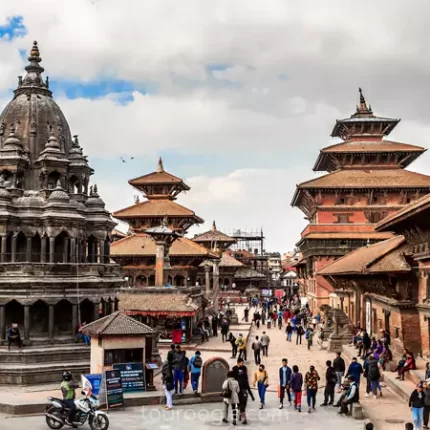

With the Great Himalayas standing tall on its northern borders and Mount Everest as the crowned king of the world, Nepal is truly the kingdom of mountains and heaven for mountaineers. Don’t let the peaks fool you, though; Nepal has extraordinarily diverse geography. The highest peaks on earth reach sea-level plains within a short distance. In the hilly regions between the two lie the country’s fascinating cities.
Nepal has a rich history rooted in the Hindu religion, and there are temples everywhere you look. It is a multi-religious, multi-ethnic, and multi-cultural country; therefore, for decades, it’s been a hub for hikers, mountain trekkers, tourists, Hindus, Buddhists, and culture vultures in general.
Generally, Nepal has a humid climate. The weather is hot from June to September, and monsoon rains are frequent, especially in central Nepal. From October onwards, there’s less rain, and the weather gets a bit cooler. We recommend making your travel plans for the post-monsoon period, especially between winter and spring when the weather is fresh and the mountains are visible. If these dates are not suitable for you, February-April may be a good option.
India has an endless variety of cultures, traditions, landscapes, historical monuments, exciting and touristic places, etc. These features make India attractive, and tourists plan their vacations every year.
India, a thriving Asian country with unique cultural contrasts, has a lot to say. This land is exactly where the traditional and modern worlds meet, which can arouse the curiosity of tourists and adventurers.
Don’t let the small size of the country fool you; when it comes to exploration, Nepal has everything: several UNESCO World Heritage Sites, the best trekking options, beautiful natural scenery, historical and religious monuments, and of course, good food. Kathmandu, the capital, is a lively place and a must-visit that offers opportunities to observe and mingle with the country’s culture.
The old and interesting places
The places to visit in India are numerous. You will see thousands of temples and cities in this country, so plan your trip to India long and open-ended. Let’s list the places to visit in India.
Taj Mahal
The Taj Mahal is a masterpiece built by Shah Jahan for his wife, who died at a young age. Taj Mahal, which is on the UNESCO World Heritage List, is at the top of our guide to visit on an India tour.
Amber Castle
The Amber Castle was built in the 16th century. It is made of materials like marbles and sandstones. Travelers visit this place by riding elephants.
Red Castle
The Red Fort belonged to the Mughal emperor Shah Jahan in the 17th century; his dynasty lived in this magnificent structure for 200 years.
Hawa Mahal
Hawa Mahal, which means Castle of the Winds, belonged to Maharaja Sawai Pratap Singh. Do not end your trip without visiting the Hawa Mahal in Delhi.
Qutub Minar
Qutub Minar is a fantastic victory monument from the 13th century.
Golden Temple
Amritsar is a city on the Pakistani border. There is a golden temple whose real name is Harmandir Sahib; it is a holy place in the Sikh faith.
Meenakshi Amman Temple
The building of the Meenakshi Amman Temple started in the 1st century and developed until 1500 years. It is complex and full of colorful sculptures.
Humayun’s Tomb
Humayun Tomb is a Mongolian architecture; it was completed in 1572.
Nepal is a landlocked country in South Asia. On its southern and western border lies India, while the Himalayas cover its northern borders with Tibet. Historically, Nepal has been part of the Silk Road. This has influenced its culture as well as its economy.
While Nepal is culturally diverse, most people live according to the Hindu religion. The economy relies mainly on tourism and agriculture, and many people earn their living from farming crops. Nepalese people are friendly and humane. They have adopted the principle of living in peace.
Being a Buddhist hotspot, Nepal celebrates all major and minor Buddhist holidays and hosts many festivals. Some Muslim holidays are also observed in Nepal. One of the major Hindu festivals is Holi, also known as “the Festival of Spring” or “the Festival of Colors.” The festival is a national holiday both in Nepal and India. It marks the end of winter and the beginning of spring. On this day, people light bonfires and color their faces, houses, and each other.
The native language of the people of Nepal is Nepali. However, more than 100 languages are spoken in Nepal as mother tongues. Many of these indigenous languages or regional dialects aren’t even written. In the capital, many people speak English, though.
The Nepalese culture combines different ethnicities, and the cuisine is no other. With a mixture of east Asian tastes, the traditional Nepalese dishes are healthy and rely heavily on vegetables and grain. Meat also forms a part of the diet, although some ethnic groups abstain from some forms of meat. Every ethnic minority in Nepal has its cuisine, and it is too diverse to be elaborated upon here, so instead, here’s a list of the most famous traditional Nepalese dishes: